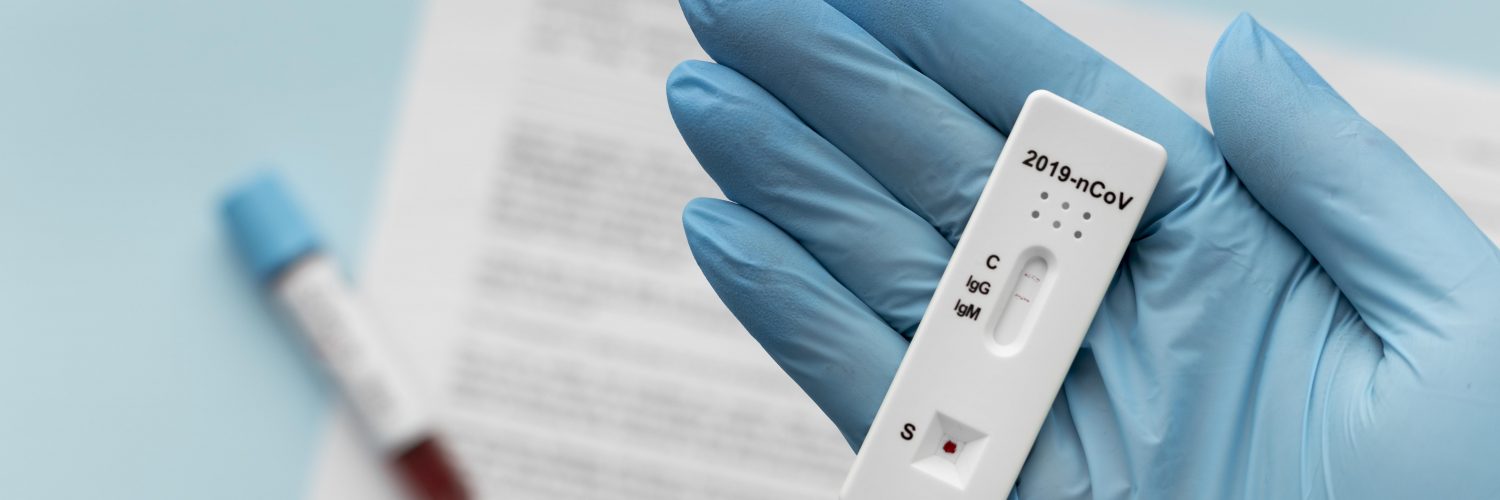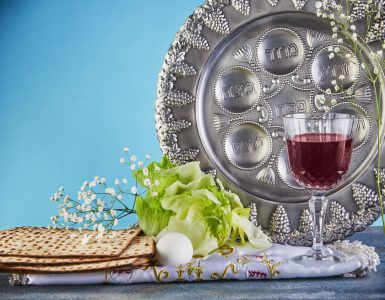Home diagnostic testing has become common, especially rapid antigen tests for COVID-19. The COVID test is performed by inserting a swab into the nose and then into a testing card or cartridge, adding a reagent solution, and waiting for lines to appear. There should be at least one colored line representing the control, and two lines indicate the presence of the virus. This is similar to home pregnancy tests and other rapid tests for other illnesses.
Can these tests be used on Shabbos?
The first concern is Meleches Tzovei’a. The Poskim define the Melacha as coloring for the purpose of the image or color, e.g., painting a picture or a wall. However, as there is no deliberate intention to change the color of the indicator, it would not be an issue of Tzovei’a.
This is the basis for the Kehilos Yaakov’sdistinction (Shabbos 40) between the Melachos of Tzovei’a and Kosev. In the former, the dye or paint improves the material, while in the latter, the desired outcome is the written message. Words cannot exist in mid-air, so they must be written on a surface, and the paper serves the words by providing them a base.
This idea was already stated by the Chasam Sofer (Kesubos 5b) regarding the reason that intercourse with a Besula is permitted on Shabbos. The Minhag was to place a cloth on the bed to ascertain whether there was Dam Besulim; why isn’t this Tzovei’a? He answers that since the point is not to color the cloth but to check for blood, it does not constitute Tzovei’a. The cloth is not improved by the presence of the blood; on the contrary, it dirties it; thus, it cannot be Tzovei’a.
In other words, even when we intend for the “dyeing” to occur and we have some use for it, it does not constitute Tzovei’a if it does not improve the material that is being dyed.
This is also the reason that a Nida is permitted to perform Bedikos on Shabbos, even though she thereby stains the Eid Bedika. The Shulchan Aruch haRav explains (Kuntres Acharon 302):
Certainly, the appearance of the color is not significant since he has no interest in it at all and it is not typical to desire it… This must be the case; otherwise, it would be forbidden for a woman who became a Nida to place a pad due to Tzovei’a.
In other words, even though a Nida wants to see the blood (if there is any), it is not for the sake of dyeing or changing the color of the cloth, so it is not Tzovei’a.
In this vein, the Shemiras Shabbos Kehilchasa (33, comments to Se’if 20) is inclined to permit urine tests on Shabbos in which color changes on a test strip indicate the presence of blood or glucose. However, he ultimately concludes that one should avoid performing such tests (unless it is to prevent Sakanas Nefashos “or even only a Safek Sakanas Nefashos”), citing Rav Shlomo Zalman Auerbach zt”l who argued that urine tests are unlike the Bedikos of a Nida, because “she merely wishes to check if there is blood or not. Only because it is impossible to do so with a finger must she use a cloth… However, in our case (of urine tests), we are interested in the change of color caused by the urine. If so, it might well constitute Tzovei’a.”
In other words, there is a difference between the two cases. When performing a urine test, we need to see the color change. However, a Nida merely wants to see the blood; it just happens to be that she may need to use a cloth to do so. This means that there is no actual purpose to coloring the cloth.
R’ Neuwirth zt”l cites Rav Shlomo Zalman as being unsure if this is truly Tzovei’a as the color change of the indicator itself is only desired to reveal a “Davar Acher” (i.e., whether blood or glucose is present in the urine), so perhaps it is not similar to the Melacha done in the Mishkan. Because of this uncertainty, Rav Shlomo Zalman advised performing the test by allowing the urine to come in contact with the test strip “on its own” so it would be considered a Grama.
The second Melacha to address is Kosev. Kosev includes not only writing actual words but even making markings or pictures (which are Asur mid’Rabbanan). Does the appearance of lines on the test card or cartridge constitute Kosev?
The Shulchan Aruch rules (O.C. 340:5): “It is permissible to make a mark in a Sefer with a fingernail, as one does as a symbol, since this is not something that persists.” The Mishna Berura (ibid. 24) explains: “But only a mark like a simple line as a reminder of a printing error since this is not considered writing anyway. To make the form of a letter, however, is certainly forbidden, even one letter.”
Although the Mishnah Berura asserts that it is not considered writing, the fact remains that the Shulchan Aruch permits it only in a case where the mark is not lasting. If it were a permanent mark, it seems that it would be an Isur d’Rabbanan.
The result lines that appear remain in place for a long time and perhaps should be considered permanent. On the other hand, the category of “Davar she’Eino Miskayem” (something that does not persist) may also include things that are not kept for long. Since the test is designed to be used only once and is discarded after use, some say it is a “Davar she’Eino Miskayem”.
Another possible reason for leniency is that the dye that forms the lines is already present before the test is performed, and it simply becomes visible now due to a chemical reaction. According to the Shemiras Shabbos Kehilchasa (40:9), this would still be Asur mid’Rabbanan. He bases this on the Pri Megadim’s ruling regarding “secret messages [written] with unpasteurized milk that is absorbed into the paper and is invisible. When someone draws it near a fire, the writing becomes visible”. The Pri Megadim asserts that this is an Isur d’Rabbanan.
Rav Shmuel Wosner zt”l (Shevet haLevi, 7:106) was asked about a child with kidney disease whose parents were instructed by doctors to withdraw gastric contents daily[1] and place it on indicator paper that would change from blue to red as an indication that the child was healthy. Could this be performed on Shabbos?
First, Rav Wosner explains that it is not a Melacha d’Oraisa of Kosev. Using the test is not writing but simply performing an action that causes the color to change. The same argument can be made about Tzovei’a. Moreover, the color change may not even occur[2], thus, it is a Safek d’Rabbanan.
However, Rav Wosner concludes with the caveat that his Heter is restricted to the situation when the color or dye is already there. If the color change is dependent on adding a reagent, it might not be similar to the case of the Pri Megadim.
What about rapid antigen tests? On the one hand, the chemicals are already in the test cartridge or card, and the reaction with the antigen causes the line(s) to appear. On the other hand, the color is not apparent before doing the test. Perhaps this means that this case is more stringent than when the words were written but not visible until heat was applied. Here there was no writingor color at all; the test itself causes the line(s) to form when the reagents and sample react. On the other hand, the surface on which the lines appear and the color itself was already in place but just required the addition of the sample to cause the lines to appear. This requires further study.
In any case, Rav Wosner only permitted the test in a case where there is a Safek if the color will change. In the case of rapid antigen or other tests, the control line will certainly appear (if the test is performed correctly); the Safek is only if the second line will appear. If so, Rav Wosner would also forbid it.
Rav Yehoshua Neuwirth zt”l (Ateres Shlomo 7) discusses all the aforementioned considerations. His main consideration for permitting the use of medical tests on Shabbos is that they are discarded after use. It is not Tzovei’a because it is Derech Lichluch, essentially ruining it. He relates that he heard this from Rav Elyashiv and that it is permissible “b’Sha’as haTzorech”. However, he cites the Sefer Yashiv Moshe who quotes Rav Elyashiv as ruling that if dyeing will unavoidably occur, it does constitute Tzovei’a, and Rav Neuwirth discusses whether it is mid’Oraisa or mid’Rabbanan.
I could not find the Sefer Yashiv Moshe. However, I did see the Sefer Vayishma Moshe (1, p125) that quotes an explanation from Rav Elyashiv regarding the Shulchan Aruch’s ruling (320:20) that while eating strawberries a person should be careful not to stain a tablecloth or his clothes. What about wiping his hands on a disposable napkin? Rav Elyashiv replied that it is permissible: “Concerning anything that is immediately thrown out… Tzovei’a is not relevant”. (This is also the position of the Shemiras Shabbos Kehilchasa 14:21.)
Rav Yochanan Berger, in an essay on the subject, argues that medical tests are Tzovei’a sheLo k’Darka. He draws an analogy from the Shu”t Hisorerus Teshuva’s Heter to perform Bedikos during the Shiva Neki’im, since the discoloration of the Eid Bedika is not the regular way to color fabric.
However, the two cases would not appear to be comparable. The method of Tzovei’a is not uniform; it depends on the item being colored or dyed. Painting a wall is different than painting on paper or painting letters. Each type of Tzovei’a is carried out in a different way and with different tools (such as a paintbrush, pencil, or marker) and with different types of dye or paint (such as whitewall, charcoal paints, etc.). Despite this, there is no difference in Halacha; all methods and tools are included in Tzovei’a. Therefore, since these tests are common and color changes occur by design, it is difficult to say that it constitutes Tzovei’a sheLo k’Darka.
HaGaon Rav Asher Weiss Shlit”a wrote a Teshuva concerning sugar and fertility tests. He concludes that one may be lenient in the case of a Choleh she’Ein Bo Sakana or where there is a great need. His arguments are:
- As mentioned, since the swab is disposed of immediately, using the test is not a lasting Melacha.
- Since it is not Tzovei’a for its own sake; rather, it is to ascertain certain results, it may be a Melacha she’Eina Tzricha l’Gufa.
(These two reasons reduce it to an Isur d’Rabbanan.)
- Tzovei’a only applies only when the coloring is for the sake of the item being colored.
However, Rav Asher’s main argument is fascinating:
This does not fall into the category of Tzovei’a since the Melacha is only when the dye is placed onto something, and the dye that is absorbed is the dye that one placed on the item. However, in our case, the color that appears is not the coloring agent that one placed. The coloring that takes place is created by a chemical reaction. This is not Tzovei’a at all. I have written similarly elsewhere regarding eyeglass lenses that darken when exposed to sunlight, or a temperature-measuring strip that changes color when it is exposed to heat, that they also do not constitute Tzovei’a since the color is not introduced by the person; the color change is caused by external factors that affect the components of the [lenses or thermometer]. The same would seem to apply here. In sum: Tzovei’a is only effected by applying color, not by causing a change of color by a chemical reaction or the like. Though I do not have proofs to this concept, it is obvious to me in logic. It would seem that one could also discuss [the following]: Even if we concede that this does constitute Meleches Tzovei’a, it is nevertheless not Tzovei’a b’Yadayim (performed directly). It is only a Grama (indirect), and we know that in the case of a Melacha d’Rabbanan, Grama is not Asur. We already explained that this is only a d’Rabbanan because it is a Melacha she’Eina Tzricha l’Gufa since it is impermanent. Ultimately, it would seem that all of these arguments can be combined to permit these tests on Shabbos when necessary.
There is more to discuss regarding this fascinating topic. However, in the interest of brevity, we will summarize:
As mentioned above, the Shemiras Shabbos Kehilchasa permits the use of home tests if they are used in an unusual way, namely, by allowing the liquid to contact the test card or cartridge on its own rather than applying it directly, which constitutes Grama.
However, the Orchos Shabbos rules that it is only permitted in cases of Pikuach Nefesh (1, 15:67). In footnote 97, he cites Rav Shlomo Zalman’s view but ultimately rules stringently. Rav Asher’s position is that one may use these tests in case of need [or Mitzva], such as if a person would like to go to shul or to visit his parents.
[1] [Editor’s note: The Sh’eila references a “Tzinor”, which most likely refers to a gastrostomy or nasogastric tube.]
[2] Since it will only change if everything is in order, and in the case of a Choleh it is common for the change not to occur, so it is a “Safek haShakul”.















Add comment